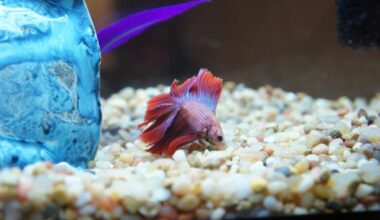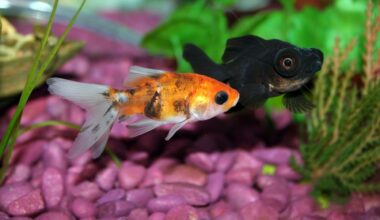Many aquarists have different reactions when they see snail eggs in their aquarium. Some want them out immediately, others are curious, a few want to keep them, and many aren’t sure what they’re looking at!
This resource will teach you everything you need to know about freshwater snail eggs. It covers where to find them, what they look like, and what you can do with them.
Table of Contents
What Do Snail Eggs Look Like?
Snail eggs are just as varied in appearance as adults! Each freshwater snail species lays unique eggs that are distinct and identifiable. So, the exact look of the eggs will depend entirely on the snail species you have.

That said, you’ll know that you’re looking at snail eggs when you see them.
These inverts lay tiny eggs in small clusters. Some species can produce individual eggs, but most are going to lay several at one time. Usually, the eggs stay contained in a protective gelatinous sac.
The color of the eggs will depend on the species. Some are vibrant blue or pink. However, most are white or cream-colored. They’re also semi-transparent and appear to have a jelly-like texture.
If the eggs are fertilized and partially developed, you might see little flecks of black or brown. Snail eggs tend to darken over time as the tiny snail embryo inside grows. Unfertilized eggs, however, will maintain their appearance before souring.
Where Snails Usually Lay Their Eggs
Here’s where things can get tricky! Many freshwater aquarists notice snails appearing without any warning signs whatsoever. These aquatic creatures have a knack for hiding their eggs in some of the most overlooked places.
Snails don’t exhibit too many parental instincts. However, they make sure that the eggs are protected and in an environment conducive to their growth and survival.
One of the most common places you’ll find snail eggs is under plant leaves. Snails favor larger broad-leaf plants, but they can also lay eggs in smaller floating plants or dense grasses.

Snails and their eggs are notorious hitchhikers in the fish-keeping world. It’s how unwanted infestations occur! If you ever end up with snails in your tank without buying them, they probably came as eggs on plants you added to your aquarium!
That’s why it’s important to quarantine plants before introducing them to your aquarium.
You can also sometimes find eggs on decorative items. Snails can choose to deposit eggs on driftwood, rocks, plastic decorations, or even on the glass’s smooth surface.
Author Note: Some freshwater snail species have the ability to breathe atmospheric air and live on land. These species tend to find a happy medium for their eggs, laying them on those few inches of open space between the lip of the tank and the water’s surface. There, the eggs can stay moist without being submerged.
Because most aquarists rarely remove the lid entirely, these often go unnoticed.
What You Can Do With The Eggs
You have a few ways to deal with snail eggs once you find them. The relationship between snails and aquarists is a contentious one. On one side, you have those who welcome these mollusks while others absolutely despise them!
The right choice for you depends entirely on your personal preferences, the needs of your tank, and your aquarium inhabitants’ safety. Here are a few ways to address snail eggs.
1. Keep Them
If you’re looking for a hands-off approach, you can keep the eggs and let them hatch naturally.
Freshwater snail eggs are pretty self-sufficient. You don’t need to do anything to encourage hatching. The sac that encases the eggs will do much of the heavy lifting, providing the protection and nutrients they need. Just let the eggs be!
Having snails in your tank can actually be quite beneficial. That’s why you see so many exotic species sold in pet stores!
Snails are part of the elusive “cleaning crew.” They help to pick up plant detritus and waste that would otherwise ruin the water conditions. Not only that, but they spend their days as fantastic algae eaters that eat whatever accumulates throughout the closed environment.
Like plecos and shrimp, they can serve a valuable and practical purpose. While they won’t replace the filtration system, these creatures can do a lot to cut back on your cleaning duties.
If you have a chronic algae problem, why not let those young snails take care of the problem? They can make quick work of algae buildup, making the issue more manageable. Now, you may have to supplement their food with algae wafers and vegetables. But the continued algae clearing is well worth the added work.
Author Note: Keep in mind that snails are prolific spawners. It doesn’t take long for a single clutch of snail eggs to turn into a severe infestation. The population can explode pretty quickly. If you’re not taking measures to manage the rate at which your snails reproduce, you could be looking at a serious snail problem in the future.
2. Use Them To Feed Certain Fish
If you have snail-loving fish species, you can create a pretty reliable source of food.
Certain fish species thrive on a diet of high-protein and calcium-rich snails. Pufferfish need to crunch on those hard shells to keep their teeth in good shape.
It’s not just the puffer that can eat snails and their eggs. Some other fish with an appetite for these mollusks include:
Author Note: There’s also a species of snail that will eat other snails! These are known as assassin snails.
You can provide the eggs to these fish directly. Alternatively, you can let them hatch first. Some of the fish above will only eat baby snails that are easier to digest.
Some freshwater aquarists like to take things even further by creating a separate snail hatchery. If you see the egg clutch, you can move it into a quarantine aquarium where they can continually hatch and reproduce. Thanks to their fast reproduction cycle, you can have an ongoing food supply that doesn’t take much to upkeep.
Even if you just let the eggs hatch in the original tank, you might see your fish consuming young snails every once in a while. These fish species are wonderful for controlling the snail population and preventing over-the-top infestations.
3. Dispose Of Them Before They Hatch
The final option for dealing with snail eggs is to dispose of them.
It’s perfectly reasonable not to want snails in your freshwater aquarium. For many aquarists, these creatures are nothing more than a nuisance.
A growing population of snails isn’t just a cosmetic issue. Snails produce bioload like any other tank inhabitant. On its own, a single snail’s contribution to the waste buildup is pretty insignificant. But what about when there are hundreds of snails in the aquarium?
Suddenly, an out-of-control population is not a minor issue.
Too many snails can quickly raise the ammonia and nitrate levels in the water, killing off healthy fish and creating a toxic environment.
If you want to avoid this risk altogether, physically remove the snail eggs and dispose of them humanely.

For eggs stuck onto the glass, you can use a razor to gently remove the sac. The protective sacs are sticky and can be a little stubborn. Forceful removal may result in a rupture, which could spread the eggs inside and make them more difficult to remove
Be gentle when transferring the snail eggs out of the aquarium to avoid any complicated messes.
The most humane way to dispose of the eggs is to place them in the freezer for a few hours. The cold will halt the development, allowing you to toss them in the bin or compost. Alternatively, you can pop or squish the eggs and let any fish you have gobble up the remnants.
Are you worried about any hitchhiking snails on new plants? There are many ways to treat plants prior to adding them to your main tank.
Quarantine all plants in a closed tank. You should also visibly inspect them to remove any eggs that are left behind.
Author Note: For an added security measure, you can also dip the plant. Many commercial and homemade dips are available to rid your plants of eggs and prevent unwanted snail problems.
How Long Does It Take For Snail Eggs To Hatch?
The gestation period for eggs varies from one species to the next. Not only that, but environmental conditions can speed up or slow down the process, too.
On the lower end of the timeline scale, you might see the eggs hatch in as little as two weeks. Some species, however, can take as long as eight months!
Some snails can also hold onto fertilized eggs for several weeks before laying them. As a result, there’s no way to guarantee a hatching timeline.
As far as water conditions go, the temperature, pH levels, and hardness come into play. Generally, warmer temperatures can reduce the incubation period. A few degrees can go a long way with sensitive eggs.
The same goes for pH and hardness. Some snails prefer hard water and alkali environments. The eggs will still hatch in other conditions, but pristine parameters will dramatically reduce development time.
Final Thoughts
Snail eggs in a freshwater aquarium don’t have to be the end of the world. Dealing with them is significantly easier once you know the information above!
If you’re still a bit unsure about a snail egg situation you have in your tank we’re always happy to help. Just send us your questions!

